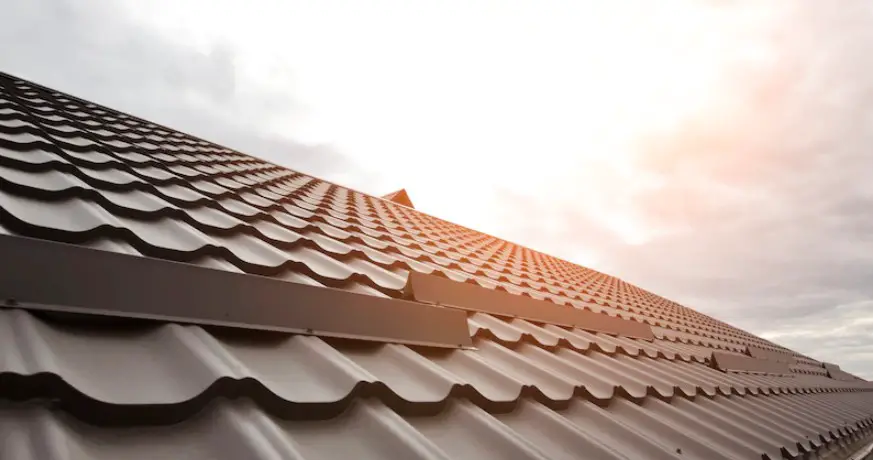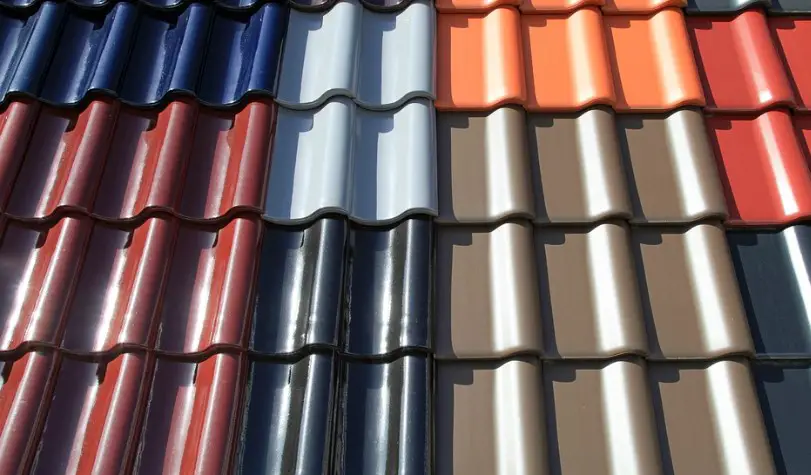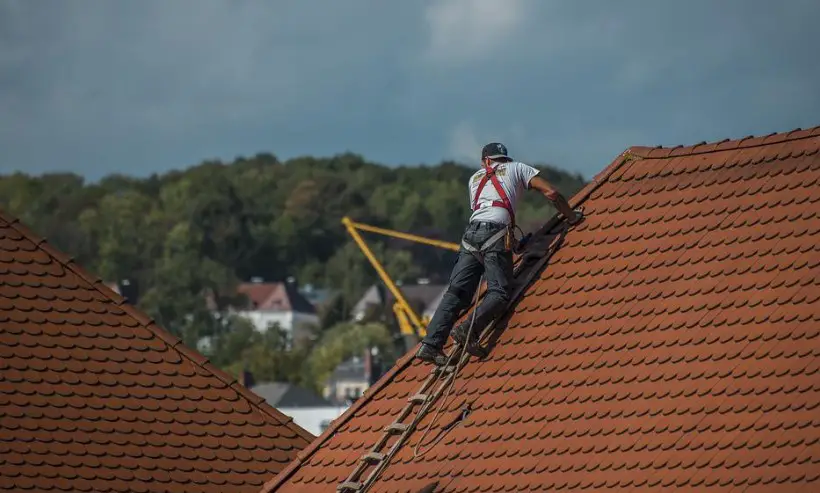Last Updated on July 10, 2023 By Emma W. Thomas
Roof tiles are commonly used in various European countries due to several reasons. Firstly, roof tiles offer excellent durability, with some types lasting for centuries. They are resistant to weathering, fire, and pests, making them a reliable choice. Additionally, roof tiles provide good insulation properties, helping to regulate temperature and reduce energy consumption. They also contribute to the aesthetic appeal of traditional European architecture, adding a distinct charm and character to buildings.
This article takes you through everything you need to know regarding roof tiles and their use in Europe. Keep reading!
What are roof tiles made of in Europe?

Roof tiles used in Europe are typically made from a variety of materials. The specific material used can vary based on regional traditions, climate, and architectural styles. Some common materials include:
- Clay: Clay tiles are a popular choice in many European countries. They are made by shaping and firing clay in kilns. Clay tiles provide excellent durability, insulation, and a classic aesthetic.
- Concrete: Concrete tiles are another commonly used option. They are made by mixing cement, sand, water, and sometimes additives. Concrete tiles offer durability, affordability, and a wide range of color options.
- Slate: Slate tiles are known for their natural beauty and longevity. They are made from thin sheets of slate stone, which are split into individual tiles. Slate tiles are highly durable, fire-resistant, and provide a distinctive appearance.
- Ceramic: Ceramic tiles are manufactured by firing clay mixed with various minerals. They are often glazed for added protection and aesthetic appeal. Ceramic tiles are available in different shapes, sizes, and colors.
- Metal: While less common than other materials, metal roof tiles are used in certain European regions. They are typically made of steel, aluminum, or copper. Metal tiles offer durability, lightweight construction, and a modern aesthetic.
It’s important to note that the availability of specific materials can vary from country to country within Europe, and local building regulations and preferences may influence the choice of roof tile materials.
Types of Roof Tiles’ Shapes
Roof Tiles come in different shapes. This gives an individual the needed allowance to choose what they refer to. Tastes and preferences are necessary for selecting suitable roof tiles.
The following are some of the known shapes;
1. The Flat tiles
These are one of the simplest known tiles. They can be made from different materials such as wood, plastic, concrete, or even stone; however, clay is the most common material used. The most common type is the Beaver tiles, used mainly in Germany.
2. Plain clay tiles
Designed in 1477 during Sir Edward’s reign, they are known to be good quality. Through the years, the design has advanced and is now more pretty and more presentable. Most people prefer them because of their aesthetic property and their providence of environment-friendly conditions. Their traditional model of manufacture is still being used in many areas in Europe, but most producers use the modified formats.
3. Imbrex and Tegula
These ancient Roman tiles create a channel impression on the roof. They are made from two main shapes; curved and flat tiles.
4. The Roman Tiles
Have you ever pictured a combination of shapes where one end contains a different design from the other ends? Then there are just those tiles. With a concave curve design on one end, thrilling convex curves on the other end, and fat shapes in the middle, these tiles are admirable. The end product is just an awesome vibe with all these shapes interlocking!
5. Pantiles
This shape is arrived at by putting the S-shaped pattern, which allows the interlocking of tiles to resemble a field that has just been plowed. It is a different and elevated design, hence earning double Roman tiles.
6. Monk and Nun Tiles
They are also named Barrel or Missionary tiles. They are of a semi-cylindrical shape and are laid in different designs to achieve the concave, convex design. Initially, they were made by attaching clay to a slightly curved surface. However, through advancements, especially in technology, today, they are made from either concrete, plastic, clay, or strictly metal.
Pros and cons of using roof tiles
Using roof tiles has several pros and cons that are worth considering:
Pros:
- Durability: Roof tiles are known for their longevity, with some types lasting for decades or even centuries.
- Weather resistance: Tiles can withstand harsh weather conditions, including heavy rain, snow, and high winds.
- Fire resistance: Many roof tiles, such as clay and concrete, are inherently fire-resistant, offering added protection.
- Aesthetic appeal: Roof tiles contribute to the architectural charm of buildings, adding a distinct and appealing look.
- Insulation properties: Certain types of roof tiles, like clay and slate, provide good insulation, helping to regulate temperature and reduce energy consumption.
- Low maintenance: Once installed, roof tiles require minimal maintenance, reducing long-term costs.
Cons:
- Cost: Roof tiles can be more expensive to install compared to other roofing materials, such as asphalt shingles.
- Weight: Some roof tiles, particularly those made of slate or concrete, can be heavy, requiring proper structural support.
- Fragility: Tiles can be susceptible to damage from heavy impact or foot traffic, requiring care during maintenance or repairs.
- Installation complexity: Proper installation of roof tiles often requires specialized skills and expertise.
- Limited color options: Compared to other roofing materials, the range of color choices for roof tiles may be more limited.
- Availability: Certain types of roof tiles may be less readily available in some regions, potentially leading to sourcing challenges.
Essential factors to consider when selecting or choosing tiles

Know what you want before you start
This is the most critical factor of consideration. Without prior and keen planning, you will be unsure of what you want. Be keen when planning to avoid last-minute rushes and poor decision-making, which are realized after the roof tiles have already been placed. Your choice and style preference is also a factor to consider. Never choose something that you are not completely satisfied with.
The Tile sizes
Tiles vary in size. To know the correct size, make sure you have an accurate measurement on the roof to select the appropriate size. The right size also boosts the average appearance.
The color
What do you want to achieve? What best works for you; bright or dark colors? Colors speak. Your color selection must be just brilliant. The questions stated above can be fundamental when determining which color best suits your house.
The texture and the pattern
Texture and pattern cannot miss the list. They are also of personal choice. They can be confusing, especially when you have to choose from many types. In this case, prior advice can be constructive. With the right texture and pattern, you can easily select the color. Therefore, all these factors work hand in hand to make the selection more convenient.
Quality
You want long-lasting tiles. Quality is also a reasonable consideration in this case. Make sure to select the quality that will serve you for an extended period. Advice from experts and also other customers can come in handy. Never neglect tiles on the materials they are made from. Nevertheless, materials are also of different tenacities. The company you purchase from can also be an essential consideration if you want the best quality tiles.
Other Roofing materials used in European countries

Rolled roofing
This is an upcoming trend in Europe. Each roll is about 100 square feet and has a width of up to 3 feet wide. They are mainly composed of asphalt and other mineral-oriented granules.
They are primarily used in low-sloped residential buildings and shops.
Built-up roofing
Being one of the oldest roofing methods, its pitch is relatively low. It requires several layers that are also asphalt-oriented. Each layer is applied to an already placed layer to attain a thicker layer. This process is then repeated until the intended roof size is reached.
Membrane roofing
It is also a key considered roofing idea because its end product is a well-made flat or slightly low-pitched roof.
They are a variety of this type, namely;
- Neoprene which is also called polychloroprene
- EPDM is also known as ethylene propylene diene monomer, which is synthetic and often referred to as rubber roofing.
- PVC, also known as polyvinyl chloride
- Chlorinated polyethylene and chlorosulfonated polyethylene sheets
- Polymer-modified bitumens
Asphalt Composite Shingles
Famous in North America and is made from fiberglass that has been topped with a bit of asphalt and some mineral granules.
It is famous among many people because the materials used to make the roofing can quickly adapt to roof movements: expansion and contraction.
They serve a building’s roof for a maximum of thirty years and a minimum of twelve years.
Standing Seam Metal Roofing
It is a widespread method as it combines aluminum and steel. It is very strong. It is widespread in areas that experience snow and wildfires from time to time. They act as a shield as they are fireproof.
Other roofing methods include;
- Metal shingles
- Wood shingles
- Slate shingles and also
- Rubber tiling
Final word
Roof tiles have been used in Europe for centuries for their aesthetic appeal and durability. They also have some artistic significance, but they were mainly used because they are readily available, and almost anyone could make them for themselves. Most churches and important buildings in Europe have roof tiles because of the value attached to them. Roof tiles have grown in popularity worldwide, and most people love them for being long-lasting; they can last over 50 years without repair or replacement. Most manufacturers give 50-year warranties for roof tiles.
References:
https://blog.ipleaders.in/polo-ralph-lauren-vs-u-s-polo-association-won-race/
https://en.wikipedia.org/wiki/Polo_Ralph_Lauren_vs_U.S._Polo_Association
Emma is a graduate of Domestic Science or Family and Consumer Sciences (Home Economics) from the University of Wisconsin. She has 7 years of experience Working with the strategic section of BestBuy and now writing full-time for Homeeon.
From Managing the Home, Interiors, Cleaning, and Exteriors to Gardening and everything about Making A Home Liveable – is her passion and this Homeeon is the result of this.
Emma loves decorating her home with the best stuff found online. She cares about quality over anything and writes reviews about them here in Homeeon. Get in touch with her over Pinterest.
Keep reading her blogs.

